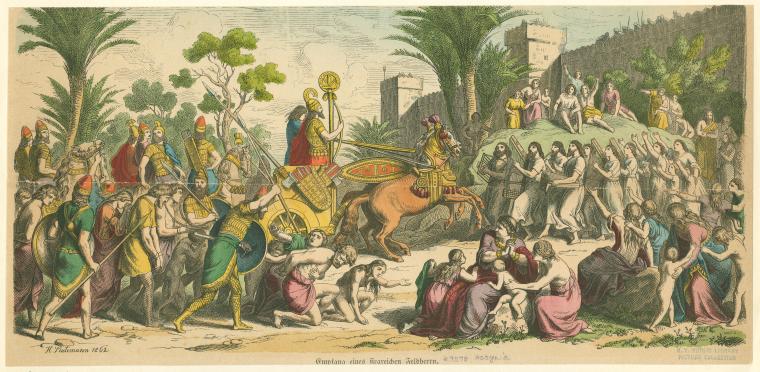Around the mid-700s through mid-600s BCE, there was a feared empire east of Mesopotamia, reaching from modern-day Iraq to modern-day Turkey and down through Egypt. This empire was the world’s first major political power to adopt an imperial structure government and the first to master iron working. This empire had many foes who succumbed to its brutal and terrifying tactics; they would lay waste to the land, often destroying entire city populations. The empire is considered the greatest of Mesopotamian empires for development of bureaucracy, military strategies, and expanse. This is the Assyrian Empire, which reigned from 1400 BCE through 612 BCE. The empire had its beginnings in 1900 BCE in the Assyrian capital of Ashur. The city grew from trading with the Hittite cities of Anatolia, which provided Ashur with raw materials needed to master the craft of iron working and increase the city’s wealth. With the mastery of iron, Assyrians could make iron weaponry, which helped them to conquer other lands that had merely bronze weaponry. Assyria become a foe in Mesopotamia because of its new weaponry, desire for more land, and cruel tactics.

Before Assyria was a great empire, it was a small region that had been conquered by the Akkadians and then the Babylonians. Once the Babylonian empire fell, Assyria attempted to assert control in the areas around Ashur, but were not able to due to the rise of different influences in the region and civil war inside. The Mitanni held power in Mesopotamia until invasion by the Hittites in 1300 BCE, bringing Mesopotamia again under a different influence; the Hittites overthrew the kings of Mitanni and conquered the region. However, during this time, Assyrian King Eriba Adad I was able to gain influence in the areas under Hittite control, and Assyrians finally saw their chance to break free and be independent. Once independent, they began to expand outward from Ashur to areas once controlled by the Mitanni, and the Hittites did not like this. War broke out between Assyria and the Hittites, but the Assyrians were much more powerful. They drove out the Hittites from their major strongholds and conquered their land from the north and south. Assyrians proved to the Mesopotamian world that they were a powerful people and a foe to be feared.1
The Assyrians’ reputation and respect was due to their war machine. The Assyrians were not only masters in iron working but also masters of siege warfare, which was a crucial tactic for attacking cities with walls. They would either light the walls on fire, dig under the infrastructure, build ramps to help soldiers jump over the wall, or use their “ramming tower.” The Assyrians knew that surrounding the city and straining it of supplies could sometimes take years if the city had a good stock of provisions and a good water source. Instead of taking years to conquer a city, they would conquer it in days. Finally, inside the city the men, women, and children would be killed like animals, and those who survived were most likely sold into a lifetime of slavery.2

The Assyrians would also introduce psychological warfare to the world. Often commanders would surround a city before besieging it and demand the city surrender or die. This would often work too. Cities’ rulers would rather save themselves and their people than be massacred. Assyrian kings would rather acquire lands through diplomacy, but if diplomacy seemed impossible, they would besiege a weakly fortified city and commit atrocities on its people. They would impale, skin, behead, and roast the unlucky defenders, then save one or two to go back to the capital to tell of the doom of their city. Kings were proud of their feared reputation, and often bragged about their atrocities, introducing an ancient form of propaganda. After committing these massacres, they would make massive stone slab sculptures that had writings and images of their brutality. They would post these on the side of roads, like a billboard today. The Assyrian kings wanted to convey the message that they were to be feared and not stopped. King Ashurnasirpal (c. 668-627 BCE) is an example of how proud these kings were, saying, “The city I destroyed, devastated. I turned into mounds and ruin heaps, the young men and maidens in the fire I burned.”3
Assyria was very disliked in the ancient world because of their brutality, but they were also not liked because of their policy of mass deportation of conquered populations. It was standard policy for Assyria to do this. Kings decided the best way to prevent rebellion was to remove the current occupants and replace them with Assyrians. If you resisted, you were killed or sold into slavery. Deportees were carefully chosen by their talents and labor that might be useful to the empire; so if you were a scribe or scholar, then you would be sent to a populated city to help the bureaucracy of the city or help catalog written works. Though this was a cruel tactic, families were never separated and their culture was assimilated into the Assyrian culture. King Tukulti-Ninurta I (c.1244-1208 BCE) was partially interested in preserving the knowledge and cultures of the peoples he conquered. If you give in to Assyria, you would be treated fairly in the Assyrian government and be considered Assyrian; however, most did not and held onto their identities.4

Assyria’s greedy expansion and war machine led to a major coalition to be formed against them by twelve kingdoms in 853 BCE. These kingdoms first held the Assyrians at the city of Qarqar. The battle could not be won but showed the Mesopotamian world that the Assyrians could be stopped. Assyria continued the invasion and began picking off the kingdoms of the east, taking them kingdom-by-kingdom. The Assyrians were held off for 150 years, delaying their conquest for Mesopotamia for about a century. The Assyrians, after conquering the eastern kingdoms, marched towards the Hebrew kingdom of Israel. At the battle Lachish in 701 BCE, the brave city Lachish stood up to the Assyrian war machine and payed the price. The Assyrian commander besieged and razed the city, and the defenders were brutally murdered. The city was strongly fortified to guard the way to Jerusalem, but once fallen, it gave Assyria a straight path to conquer Jerusalem, which they did. Assyria wreaked havoc throughout Mesopotamia and was held together by their bonds with violence and terror. Assyria conquered land after land, and with it conquered an abundance of natural resources. The Assyrians, however, offered very little to the lands, creating tension between Assyria and the lands governed by them. Especially in Babylon, the Babylonians were unhappy with Assyria and rebelled. Assyria sent their armies to suppress this rebellion, but were unable to, due to their being in an alliance between Babylon and the southern kingdoms. Babylon was able to rally the other kingdoms behind them, marched towards Nineveh, the traditional capital for Assyria, and besieged the city for three months. The Assyrians were now victims to their own tactics, which they pioneered. The city fell and the government fled to Harran to continue the Empire, but it only lasted for another four years. The once great empire had fallen, and by the time of the Persian Empire, a little over a century later, Assyria was just a memory.5
Assyria cultivated a fearsome reputation and is remembered today for many of its endeavors. They are especially remembered for their brutal militarism. Every successful ancient empire would use Assyrian tactics, like the tactics of siege and psychological warfare. The Assyrian engineers were essential for their military; they created ways for armies to siege a city. Even the road system the Assyrians had in place at the time would be emulated in other successful empires. They would have paved roads that connected one end of the empire to the other and made it efficient for armies to move in times of unrest. They even had a corps of messengers to ride the roads for swift communication in the empire. The Assyrians were also the first to systematically collect a library. On clay tablets, they would keep records of their history, mythology, and daily life. It is because of these clay tablets that archaeologists have been able to decode ancient cuneiform writing. Out of all the Assyrians endeavors, their tactics and feared reputation ultimately brought them to their fall. The deportation of large masses made the masses angry at the empire for taking them from their land, but if they did not follow through, they would be killed in a cruel way. The masses had little choice under Assyrian rule, so they chose to rebel. The Assyrian empire is a prime example of what not to do when ruling over a large mass of people from different cultures. Empires like the Romans and Greeks would adopt many aspects from the Assyrians and integrate them into their own empires. The Assyrian empire will go down as the greatest of Mesopotamian Empires but will always be remembered for their brutal and cruel atrocities committed to make a point.6
- The Greenhaven Encyclopedia of Ancient Mesopotamia, 2007, s.v. “Assyrian Empire,” by Robert B. Kebric. ↵
- The Greenhaven Encyclopedia of Ancient Mesopotamia, 2007, s.v. “Assyrian Empire,” by Robert B. Kebric. ↵
- Salem Press Encyclopedia, January 2016, s.v. “Civilians and war,” by Peter K. Benbow. ↵
- World History Encyclopedia, 2011, s.v. “Assyrian, Babylonia, and Persian Deportations,” by Alfred J. Andrea and Carolyn Neel. ↵
- The Greenhaven Encyclopedia of Ancient Mesopotamia, 2007, s.v. “Weapons and Warfare, Land,” by Robert B. Kebric. ↵
- Gale Encyclopedia of World History: War, 2008, s.v. “The Assyrian Conquests (853 BCE–612 BCE).” ↵



18 comments
Cameron Ramirez
I knew very little about the Assyrians, and I was curious to learn more about their empire and their tactics used to dominate the area. Your article dives entirely in how and why the Assyrians were able to take the area by force and what they did to do so. Your article was great, and I enjoyed reading it. The images you used helped convey your message clearly and concisely.
Tyler Sleeter
Great article with so much information! I was aware that there has always been a lot of fighting in this region that continues to modern times, but to see it laid out like it was at the beginning of this article was eye opening. I found it interesting that the Assyrians were considered a war machine and were able to conquer walled cities in mere days. Then they followed it up with replacing every one in conquered cities with Assyrians. It was interesting to see Assyria fall when the Babylonians used the Assyrians own tactics against them.
Mario Sosa
Although I was already familiar with how the Assyrians were the first to really take advantage of iron weaponry, this article gave me a whole ton of captivating information about them. I figured that the Assyrians were aggressive in conquering land but it came as a surprise to me how they were also the first to use psychological warfare against their enemies. Very fascinating article, superb job!
Morghan Armenta
Many of us maybe familiar with how the Babylonians revolted and overthrew Assyria but it never occurred to me that the only reason they knew how to mass murder an entire city was because they were using Assyrian military tactics. I really enjoyed all of the information in this article but I would of liked to of seen some size comparison to a countries nowadays to visualize just how large and tyrannical Assyria had become over all of the countries you mentioned they forcibly conquered.
Faisal Alqarni
Hello Alejandro, the Assyrians sound like a very advanced society. I think the iron age and their working masterly of iron gave them an advantage over other empires as you point out. Their methods of war which are employed to this day such as propaganda show how advanced and ahead of time they Assyrians really were. The fact that it took a coming together of 12 kingdoms and even then more than a century of holding the Assyrians off did not affect their power shows just how this people were a force to be respected but like all great empires before it and after the Assyrian Empire did fall, to its own tactics none the less. This was a beautifully written paper Alejandro thank you.
Teresa Valdez
To see that it was the Assyrians that developed iron weapons is cool, I did not know that they developed this technology. It was interesting to read about the many innovations that the Assyrians founded. However, their war tactics seem to be something out of a nightmare. This is well researched, enriched with lots of detail that makes for a great article. Great job!
Alexis Soto
I love learning about ancient cultures and military stuff. This article did both and was a great reading. You were precise in explaining the origins of the Assyrians and their impact on human history. It’s always a pleasure when I find an article about ancient times because there is always something new to learn.
Natalia Zuniga
Great job!I can tell you took a lot of time and did a lot of research for this article! I Assyrians but never know much about them, so it was great to understand them better. I remember reading about them. The photo of the painting parade was great and caught my attention, as well as your graphic of the empire was great cause gave better visual where it would be today. Overall great article!